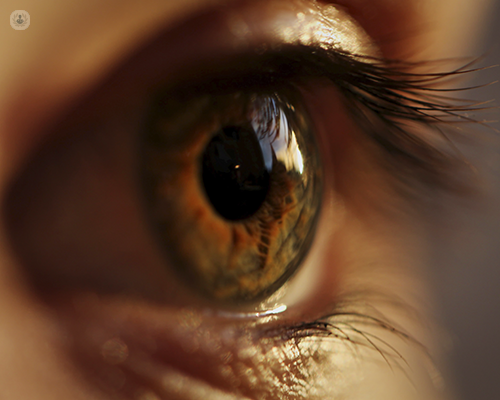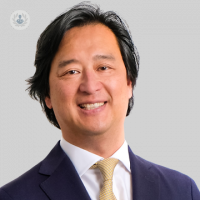SLT (selective laser trabeculoplasty): your guide to the procedure
Written by:SLT (selective laser trabeculoplasty) is a common procedure in the UK and across the world to treat glaucoma patients. When patients have high intraocular eye pressure (meaning the pressure inside the eye), SLT is an effective and safe alternative to drops treatment. Learn about this treatment from Mr Kin Sheng Lim, an internationally renowned specialist and lead for the glaucoma service at St Thomas’ Hospital in London.

What is SLT laser?
SLT (selective laser trabeculoplasty) is a simple procedure that is done in a clinic environment. The laser encourages better drainage of aqueous fluid (not tear), which is a thin and watery substance that flows throughout the eye’s chambers. The result is reduced pressure in the eye of someone who has glaucoma or ocular hypertension (high pressure).
The procedure has been around for over 20 years and is widely performed in the UK and all over the world.
When is SLT suitable or unsuitable for patients?
SLT laser is suitable for all patients with primary open-angle glaucoma, which is the most common type, or ocular hypertension. However, this procedure is generally more effective if used in the early stages of the conditions, which is usually when patients are first diagnosed. SLT can be used in patients with advanced glaucoma who have been using drops for many years and are reluctant to undergo glaucoma surgery.
Patients who have secondary glaucoma or very high pressure in the eye are generally not suitable for SLT laser.
What are the risks?
The risk of a complication from SLT laser is very small. In some patients, there will be slight redness of the eyes and light sensitivity after the treatment, but this is caused by inflammation. This inflammation, however, is generally minimised by the routine use of steroid drops for three days after the treatment. More serious complications that affect the cornea are very rare: they occur in less than one in a thousand cases. If this does occur, the vision may be blurry for two to three weeks after the procedure.
Some patients’ pressure may become higher after the treatment but this is also a very rare complication. This is because we have now excluded patients with secondary glaucoma or those who have high ocular pressure from the list of suitable patients for the procedure.
What are the benefits?
The benefits of SLT laser is that the pressure inside the patient’s eye can be controlled without the need for daily glaucoma drops. The success of SLT laser is about 75% i.e. 75% of patients who undergo SLT laser will not need glaucoma drops even after many years. Daily use of glaucoma drops can be an inconvenience and may cause problems such as eye irritation and side effects that affect the rest of the body.
What can patients expect on the day of treatment?
The procedure generally takes less than 10 minutes to perform and admission to hospital is not required because SLT is carried out in the clinic. The patient will need to attend the clinic about 20 to 30 minutes before the procedure to have some drops put into the eyes. After the treatment, there will be another short wait for checking the eye pressure before the patient is discharged. The whole episode will take about one hour in general. There is no restriction to patients’ normal routine, such as exercise or work, before or after the procedure.
Will it be uncomfortable?
SLT is very simple to perform and only requires the use of topical anaesthetic drops in the eyes. A laser mirror is used to keep the eye open and focus the laser beam. The procedure is only slightly uncomfortable but certainly does not cause any pain.
How many times do I need to be seen before and after the appointment?
Patients will require a consultation with the specialist before the procedure to make sure the glaucoma they have is suitable for this treatment. After the laser procedure, the patient will be reviewed again in 6-8 weeks’ time to see if the procedure has worked. Once we have established that the laser treatment has worked, the patient will need to be seen every 6 months.
What happens if SLT doesn’t offer the desired results?
In the patients whose eyes didn’t respond to SLT laser, we will consider either repeating the procedure or starting glaucoma drops treatment.
Mr Kin Sheng Lim is a leading specialist in the treatment of glaucoma. Visit his profile to learn more and to get in touch.


